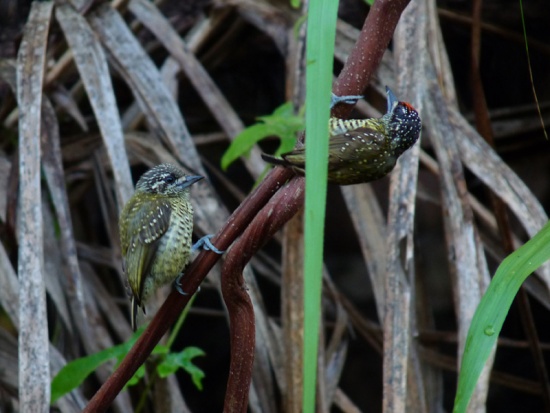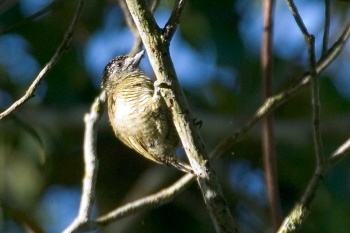- Picumnus exilis
Includes: Black-spotted Piculet
Identification
9 - 10cm. A tiny woodpecker.
- Black forehead to neck tipped white (male with feathers of forecrown tipped red)
- Buffish-white lores
- White line behind eye
- Yellowish-white cheeks and ear-coverts with dark feather edges
- Olive-green upperparts
- Pale yellowish underparts with black bars (spots in salvini/nigropunctatus)
Juveniles are duller and have a olive or greyish-white crown with off-white streaking
Distribution
South America: found in extreme eastern Colombia, Venezuela, Guyana, Suriname, French Guiana and northern and much of coastal Brazil.
A poorly known species.
Taxonomy
Clements recognizes four subspecies:
- P. e. undulatus in eastern Colombia to Venezuela, northern Brazil (Roraima) and western Guyana
- P. e. buffonii from eastern Guyana to northeastern Brazil north of the Amazon in Amapá, and south of the Amazon in northeastern Pará and northwestern Maranhão
- P. e. pernambucensis in coastal e Brazil (Pernambuco and Alagoas)
- P. e. exilis in coastal eastern Brazil (Bahia to Espírito Santo)
Habitat
A variety of habitats from rainforest to open woodland and coastal forest. Also in secondary growth with bamboo along rivers.
Occurs from lowlands up to 1900m.
Behaviour
Feeds on ants.
Forages alone or in pairs, also in mixed-species flocks. Hammers and pecks on small branches low in the forest, often hanging on thin twigs.
Breeding season December to March in Surinam and Venezuela. The nest was excavated in a branch or stump with soft wood. No other information.
Presumably a resident species.
References
- Clements, J. F., T. S. Schulenberg, M. J. Iliff, D. Roberson, T. A. Fredericks, B. L. Sullivan, and C. L. Wood. 2017. The eBird/Clements checklist of birds of the world: v2017, with updates to August 2017. Downloaded from http://www.birds.cornell.edu/clementschecklist/download/
- Del Hoyo, J, A Elliot, and J Sargatal, eds. 2002. Handbook of the Birds of the World. Volume 7: Jacamars to Woodpeckers. Barcelona: Lynx Edicions. ISBN 978-8487334375
Recommended Citation
- BirdForum Opus contributors. (2024) Golden-spangled Piculet. In: BirdForum, the forum for wild birds and birding. Retrieved 27 April 2024 from https://www.birdforum.net/opus/Golden-spangled_Piculet





